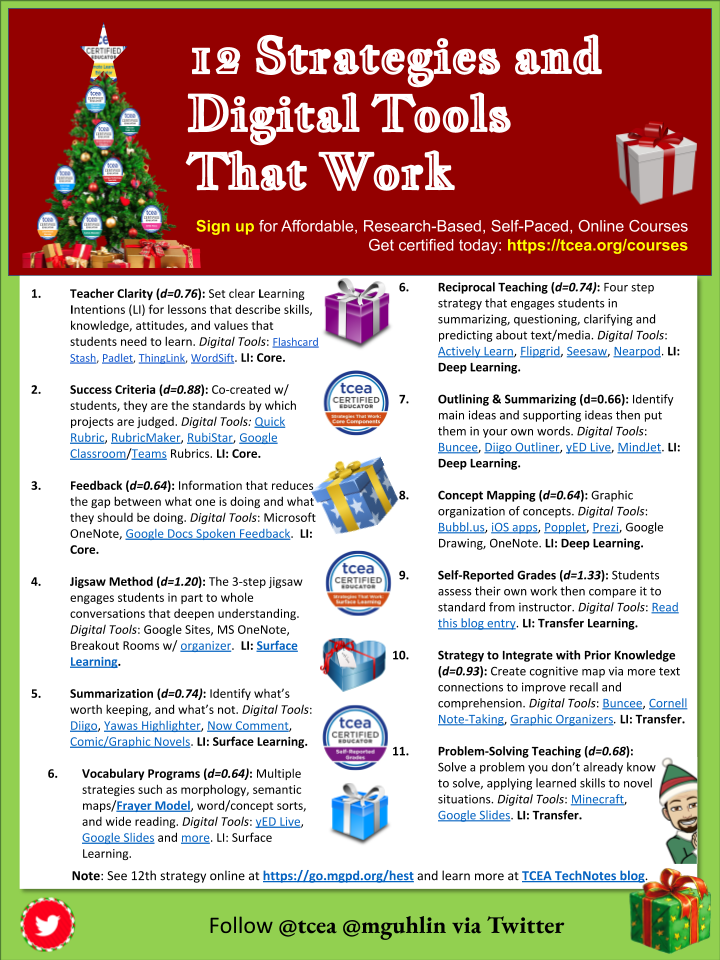
Created by author | Get the PDF version with clickable links here.
As you know, TCEA has spent the last few years diving deeply into the research of John Hattie and what strategies work best in schools today. The above PDF is a “12 days of Christmas” type of document that fuses 12 highly effective instructional strategies (for all grade levels and content areas) and the digital tools that can best support them. Explore the definitions and research behind the learning intentions (LI) outlined above, in the sections below.
Did You Know?
You can sign up for the TCEA online, self-paced course, Strategies That Work: Part 1, which explores core strategies in more detail.
Learning Intentions (LI): Core Components
- Teacher Clarity (d=0.76): Set clear lesson learning intentions (LI) that describe skills, knowledge, attitudes, and values that students need to learn. LI: Core.
- Success Criteria (d=0.88): Co-created with students, they are the standards by which projects are judged. Digital Tools: Quick Rubric, RubricMaker, RubiStar, Google Classroom/Teams rubrics. LI: Core.
- Feedback (d=0.64): Information that reduces the gap between what I am doing and what I should be doing. Digital Tools: Microsoft OneNote, Google Docs Spoken Feedback. LI: Core.
Get TCEA Educator Certified
Sign up for the TCEA online, self-paced course, Strategies That Work: Part 2, which explores surface learning strategies in more detail.
Learning Intentions (LI): Surface Learning
- Jigsaw Method (d=1.20): The 3-step jigsaw engages students in part to whole conversations that deepen understanding. Digital Tools: Google Sites, MS OneNote, Breakout Rooms w/ organizer. LI: Surface Learning.
- Summarization (d=0.74): Identify what’s worth keeping and what’s not. Digital Tools: Diigo, Yawas Highlighter, Now Comment, Comic/Graphic Novels. LI: Surface Learning.
- Vocabulary Programs (d=0.64): Multiple strategies such as morphology, semantic maps/Frayer Model, word/concept sorts, and wide reading. Digital Tools: yED Live, Google Slides and more. LI: Surface Learning.
Learning Intentions (LI): Deep Learning
- Reciprocal Teaching (d=0.74): Four-step strategy that engages students in summarizing, questioning, clarifying, and predicting about text/media. Digital Tools: Actively Learn, Flipgrid, Seesaw, Nearpod. LI: Deep Learning.
- Outlining and Summarizing (d=0.66): Identify main ideas and supporting ideas and then put them in your own words. Digital Tools: Buncee, Diigo Outliner, yED Live, MindJet. LI: Deep Learning.
- Concept Mapping (d=0.64): Graphic organization of concepts. Digital Tools: Bubbl.us, iOS apps, Popplet, Prezi, Google Drawing, OneNote. LI: Deep Learning.
Learning Intentions (LI): Transfer Learning
- Self-Reported Grades (d=1.33): Students assess their own work and then compare it to a standard from the teacher. Digital Tools: Read this blog entry. LI: Transfer Learning.
- Strategy to Integrate with Prior Knowledge (d=0.93): Create a cognitive map via more text connections to improve recall and comprehension. Digital Tools: Buncee, Cornell Note-Taking, Graphic Organizers. LI: Transfer.
- Problem-Solving Teaching (d=0.68):
Solve a problem you don’t already know how to solve, applying learned skills to novel situations. Digital Tools: Minecraft, Google Slides. LI: Transfer. - See the 12th strategy (and more) online at https://go.mgpd.org/hest and learn about Hattie at TCEA TechNotes blog.
Feature Image Source
Photo by JESHOOTS.COM on Unsplash

